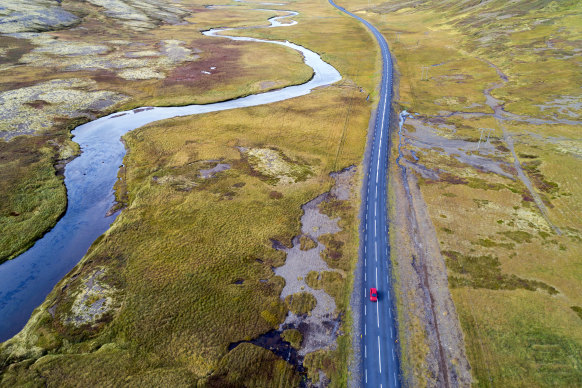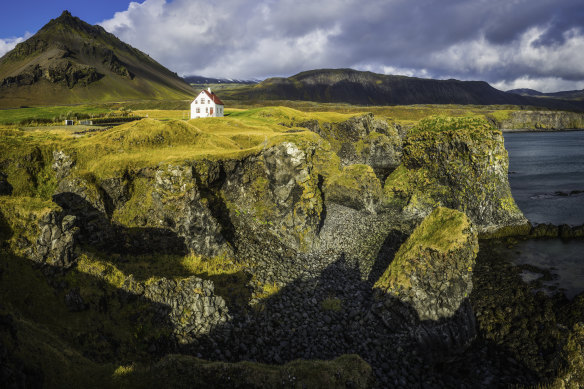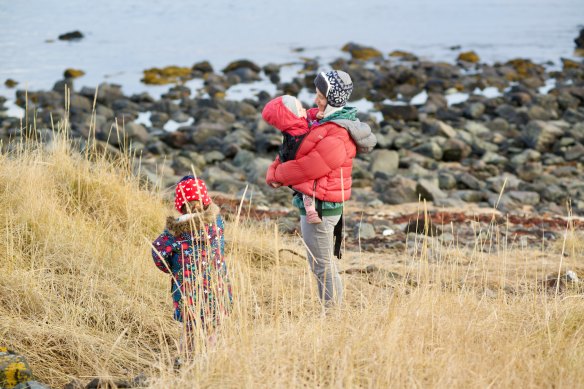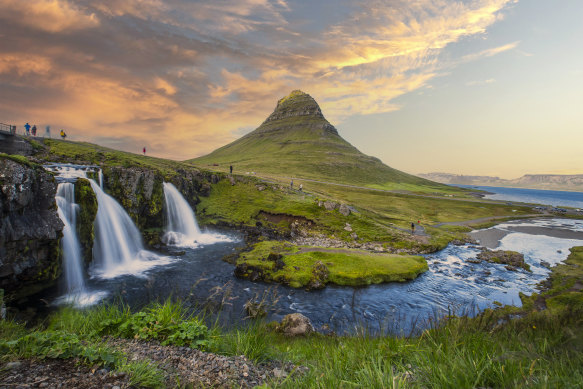Fairytales seem real in this supernatural part of Europe
Elves. They’re everywhere, moving ever so cleverly across the vast swathes of emerald green moss. Basalt knolls bulge out of the ground, and from the passenger seat of the car, the landscape looks a little like a bubbling cauldron. The cunning creatures leap from one mound to the next before vanishing into ancient lava tubes.

In the road in elf country – the Snaefellsnes Peninsula, West Iceland .Credit: iStock
I’m in Iceland with my husband and two kids, and we’re on a self-guided road trip with 50 Degrees North, loosely following the Snaefellsnes and Golden Circle self-drive route before heading south. We have an itinerary, our hotels and activities have been booked, and we mostly follow the schedule… But as any parent would know, the best-laid plans can go awry when little people are involved.
Located on the westernmost edge of West Iceland, the 90-kilometre-long Snaefellsnes Peninsula is often referred to as Iceland in miniature due to many beautiful natural features packed into a small space. At the very tip, Snaefellsjokull National Park – one of three national parks in Iceland – is a natural beauty.
As we drive along Route 54, the high midday sun pours over the fields and mountains around us, highlighting the bands of colour like a spotlight on a layered cake – moss greens, sunflower yellows, russet reds. The colours are varied and dramatic, yet I imagine that winter, when the island is carpeted in white, is just as impressive, just differently so.
My husband picks a soundtrack of moving instrumental pieces (Not Quite Classical on Spotify if you so feel) and it couldn’t be more fitting. Waterfalls plummet harder with a crescendo of violins, the ice-capped mountains sparkle as if they’ve been polished by giants, and colourful cloud formations twist and bend across the sky to piano melodies. Our elder daughter eventually gathers that there are no [visible] elves, but agrees that if elves were real they would most certainly reside in the moss fields of Iceland.
Iceland is riddled with stories about elves – locally known as álfafólk and huldufólk – hidden people from a parallel world. Not all locals believe in their existence, but many respect their myths and traditions nonetheless. In 2013 a highway construction project was paused by Iceland’s Supreme Court due to elf activists insisting that the work would disturb an important elf habitat.
Eventually – a 3.5-metre-long rock which local woman Ragnhildur Jonsdottir maintained was an elf church – was transferred to a more appropriate location so the elves could continue using it as intended. Rocks throughout the whole island have been designated elf rocks, and breaking them apart or moving them is avoided by most Icelanders.
In Iceland you can gaze at rocks all you like, though, and there are some spectacular geological formations to admire along the coastline of Snaefellsnes Peninsula. Located just off Route 54 north of Reykjavik, the Gerouberg Cliffs are a common first stop. These astonishing basalt columns have been formed by ancient lava flows, and from afar they appear like a solid wall.

A remote settlement on the ocean cliffs of Snaefellsnes.Credit: iStock
Drive closer, however, and you will notice the intricate formation of the hexagonal pillars. It’s theorised that during a volcanic eruption, rivers of burning lava tumbled down the cliffs, and as the sea water quickly cooled the lava, the unusual shapes began to form. We play “find an animal” in the elaborate formations with our eldest, much like we’ve done many times before while gazing at clouds. With binoculars wedged to her eyes, she points out giraffes and dogs, while my husband preempts our next stop by pointing out seal shapes.
Seals frequent Ytri Tunga Beach year-round, but it’s low season when we visit and we don’t mention them outright to the children just in case. The drive to Ytri Tunga Beach from the Gerouberg Cliffs only takes half an hour, then as we make our way down to the beach from the carpark we spot a small group of tourists, cameras at the ready, standing on the shore pointing at a small herd of seals.

Watching for the wildlife at Ytri Tunga Beach.
The next hour is spent meandering up and down the beach, watching the seals frolicking in the water and periodically scrambling onto the rocks. Eventually, our daughter captures the photo she’s after. To us, it’s a lopsided photo of water and rocks. To her, there’s a seal swimming in the distance. She joyfully goes back to look at it throughout the afternoon, even showing strangers when we stop for our evening meal. She doesn’t find it challenging to make friends with anyone, and everyone we meet in Iceland is happy to have a natter.
Iceland’s population is just under 400,000, and with 103,000 square kilometres of landmass, this means people have more space to live when compared to other countries in Europe. Perhaps that’s why the folk here are willing to invest in longer conversations. Or maybe it’s just that Icelandic folk are very nice.
The following day, when we stop in the fishing village of Arnarstapi, on the cusp of Snaefellsjokull National Park, my chat with one of the staff members working at a cafe that overlooks the sea concretes my theory that it’s the Icelandic people’s way. Sitting on the deck with sunbeams shimmying over the wooden tables and the seawater glimmering a sparkly blue, she tells me about the 700,000-year-old Snaefellsjokull glacier-capped volcano that the national park is named after.

Sunset at the at Kirkjufell Waterfall.Credit: iStock
The volcano was made famous by Jules Verne’s novel, Journey to the Center of the Earth, and its splendour looms over the landscape on approach. On a clear day, you can see the volcano from Reykjavik, but you only grasp its magnitude when up close. Snaefellsjokull is thought to have erupted most recently between AD50 and AD350 and here, the landscape has been moulded and shaped by lava flows and extreme weather conditions.
The Londrangar basalt cliffs are one of the most interesting volcanic remains, carved out of surrounding rocks by erosion and the sea. Nicknamed the Rocky Castle, the two protruding pillars jut out from the land’s surface like two jagged giant teeth. With the North Atlantic Ocean on one side and moss-topped lava fields on the other, their presence seems almost ominous.
As the sea hurtles wave after wave at the cliffs and the adjacent fields glisten green, I remember the local woman from the cafe telling me that farmers have never utilised these surrounding fields due to whisperings about elves residing here… Right now, staring out into the vastness, I almost believe it to be true.
THE DETAILS
The Snaefellsnes & Golden Circle self-drive tour by 50 Degrees North is a premium 10-day experience priced at $10,525 per person. It includes car hire, airport transfers, and stays in rural boutique hotels and a central Reykjavik hotel. Activities like snorkelling in Silfra, glacier walks, Blue Lagoon entry, a Viking Sushi Adventure boat tour, and more are also included.
See fiftydegreesnorth.com
The writer was a guest of 50 Degrees North.
Sign up for the Traveller Deals newsletter
Get exclusive travel deals delivered straight to your inbox. Sign up now.